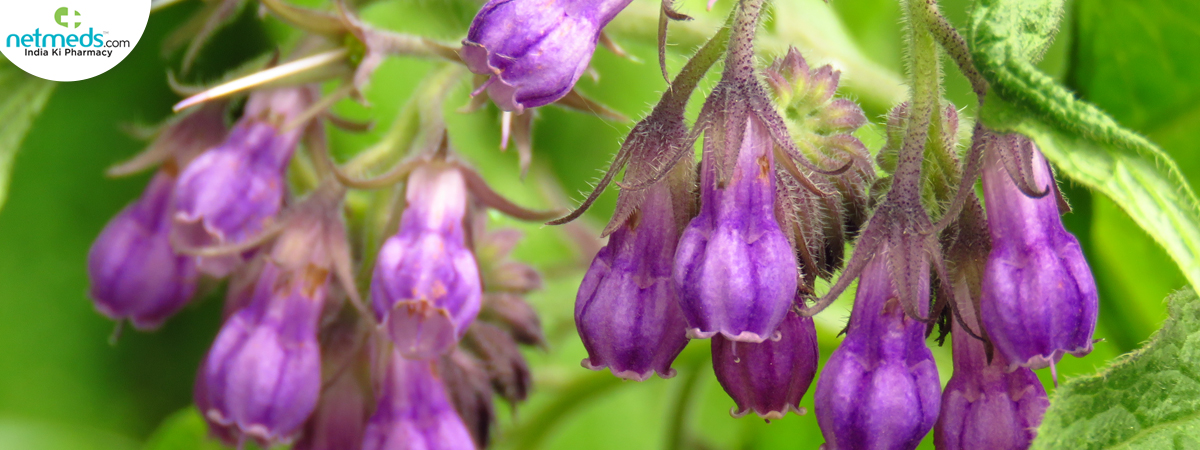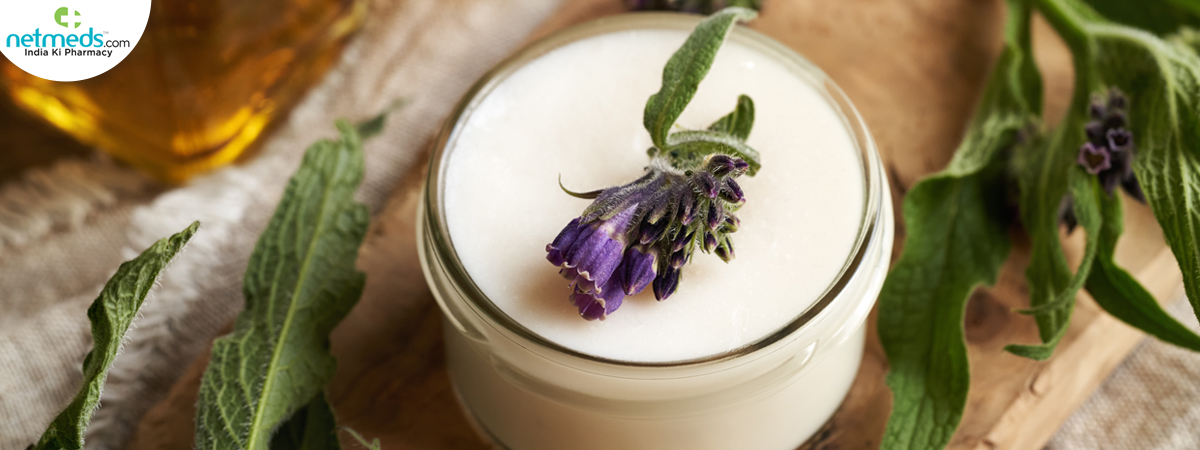A perennial herb with luscious lavender flowers, Comfrey (Symphytum officinale), primarily native to Europe and Asia, has long been prized in traditional herbal medicine for its superb skin-healing properties. Also popularly known as knitbone, thanks to its rich concentration of allantoin, rosmarinic acid, and mucilage, comfrey is increasingly gaining attention in natural skincare for its potency to help heal wounds, reduce inflammation, and promote cell regeneration. In this article, let us understand the top skin benefits of comfrey, how to use it in your skincare routine, and important safety considerations before applying it topically.
Also Read: Sensitive Skin? No Problem! How the Latest CSMS Routine Helped Me Navigate This Issue

A hardy, leafy plant with a distinctive appearance, comfrey grows in nutrient-rich soils and thus is found in damp meadows, riverbanks, and grasslands. Due to its medicinal value, the plant is being cultivated in herb gardens around the world. Hairy leaves and bell-shaped purple or white flowers, both wild and cultivated comfrey, are harvested for use in herbal remedies, especially for skin and even joint health.
5 Incredible Skin Benefits Of Comfrey
Coming to skincare, this lovely herb promises a range of natural healing benefits. Rich in allantoin and other properties, its gentle yet powerful properties make it ideal for many skin problems. Check out the top ones:
Boosts Wound Healing
Comfrey is best known for its ability to speed up the healing process of minor cuts, scrapes, and abrasions. Its active compound, allantoin, stimulates new cell growth, helping damaged tissues regenerate faster. This makes it ideal for healing superficial wounds and preventing scarring.
Reduces Inflammation and Swelling
The presence of rosmarinic acid in comfrey provides strong anti-inflammatory effects. It can help reduce swelling, pain, and redness, making it a useful herb for treating inflammatory skin conditions such as eczema, dermatitis, or psoriasis.
Hydrates The Skin
Comfrey is naturally rich in mucilage, a plant-based compound that provides a soothing, hydrating effect on the skin. It can help relieve dryness, itching, and irritation, making it perfect for people with sensitive skin.
Bolsters Skin Regeneration
Allantoin, one of comfrey's key bioactive compounds, not only promotes wound healing but also encourages skin regeneration. This helps maintain smooth, youthful skin and can reduce the appearance of fine lines, wrinkles, and pesky scars over time.
Treats Minor Burns and Sunburns
Comfrey's cooling and reparative properties make it beneficial in treating sunburns. When applied topically, it can relieve pain, reduce inflammation, and aid the healing process while also minimizing damage to the skin.

5 Effective Ways To Use Comfrey
Whether you want to treat a scrape, soothe a sudden eczema, or maybe want to give your skin a rejuvenating boost, comfrey can be a safe and effective herbal remedy when used correctly. Here is how this fragrant herb can help you get superb skin:
Comfrey Salve
One of the most popular forms of comfrey for skin is a homemade or store-bought comfrey salve. It can be applied directly to bruises, scrapes, insect bites, or cracked skin to support healing.
Comfrey Infused Oil
Comfrey-infused oil is made by steeping dried comfrey leaves or roots in a carrier oil like olive or jojoba oil. This oil can be massaged into sore joints or areas of inflammation.
Comfrey Poultice
For targeted healing, a comfrey poultice made from crushed fresh leaves can be applied to the skin and wrapped in gauze. This is especially helpful for sprains, swelling, and bruises.
Comfrey Creams and Lotions
Many natural skincare brands now include comfrey extract in their formulations. Look for creams that contain comfrey to help treat conditions like eczema, scars, or acne-prone skin.
Comfrey Bath Soak
Another way to use this herbal plant is by adding dried comfrey leaves or a few drops of comfrey oil to a warm bath for a full-body soothing treatment. This is beneficial for those dealing with extremely dry or irritated skin.
Precautions When Using Comfrey on Skin
While comfrey offers powerful natural healing, it is important to use it safely. Follow these precautions to avoid any problems, which are rare though:
· Avoid taking comfrey internally, as it contains pyrrolizidine alkaloids, which can be toxic to the liver if ingested.
· Use comfrey-based products only for short periods, especially on large areas of skin.
· Do not apply comfrey directly to deep wounds or broken skin, as it may promote surface healing faster than the inner tissue can recover, leading to complications.
· As with any new skincare product, do a patch test first to rule out allergic reactions or sensitivity.
· Comfrey should be avoided during pregnancy and while nursing due to potential risks.
(This article is reviewed by Kalyani Krishna, Chief Content Editor)
Author Profile: Preeti Sharma
Preeti Sharma has a master’s in electronic media and mass communication and certification in short-term writing from Florida. With close to a decade of experience, she specializes in crafting engaging blogs on beauty, veterinary care, and healthy cooking. Preeti is proficient in video editing tools and produces captivating and informative content across multiple platforms.
References:
Comfrey root: from tradition to modern clinical trials
Christiane Staiger
https://pmc.ncbi.nlm.nih.gov/articles/PMC3580139/
https://pmc.ncbi.nlm.nih.gov/articles/PMC3491633/



 Previous
Previous